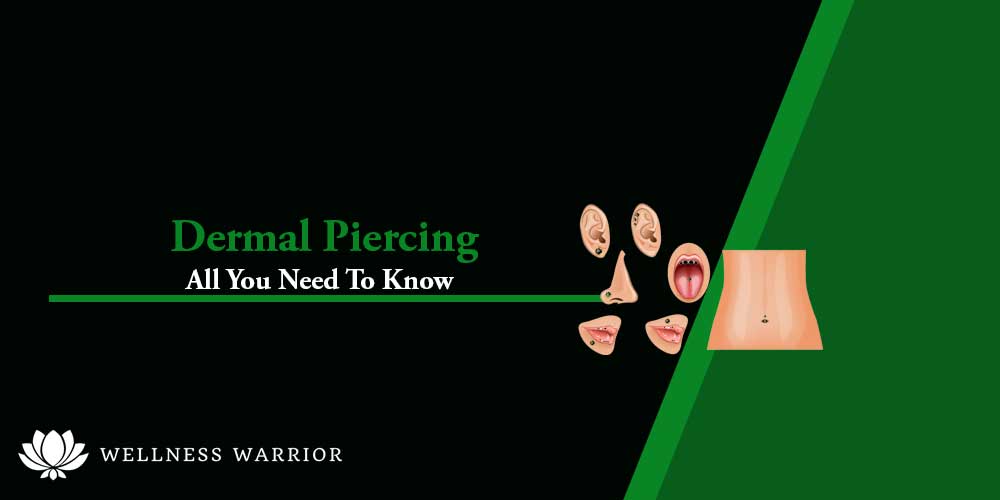Dermal piercings are a relatively new trend that’s gained popularity.
They are customizable according to your preferences and have a unique look.
Dermal piercings are a flexible fashion statement for both men and women.
It can accentuate your tattoos, ornament with jewelry, or form a pattern with multiple piercings. However, a dermal piercing should not be mistaken with traditional piercings that are more common.
A dermal piercing is more complex and a greater skill is needed for a piercer to do the procedure.
There is a lot to consider before getting a dermal piercing.
If you plan to have a dermal piercing done, it is important to be informed of its process, care and risks.
This article will help you look into everything you need to know before getting a dermal piercing.
What to Know Before Getting a Dermal Piercing
What is a Dermal Piercing
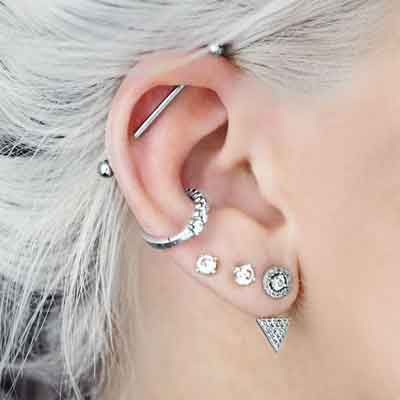
They are also known as microdermal piercings, single-point piercings, or transdermal implants.
A dermal piercing is embedded into the skin that lies on any flat surface of the body, giving off the appearance of beads on the skin.
They are held in place with an anchor inserted into the middle layer of your skin.
Dermal piercings don’t have an exit point, hence the name single-point piercing.
This makes dermal piercings distinct from ordinary body piercings, which have separate entry and exit points.
Your piercing will need more attention for aftercare and when changing it.
Dermal piercings have the appeal of having endless customization options. You can place it on multiple parts of the body.
Moreover, there are different types of anchors, jewelry, and methods.
Where Does a Dermal Piercing Go?

A dermal piercing can be placed on multiple parts of the body. It can go on almost any flat surface layer with thick skin to hold the anchor base in place.
However, other body piercing locations can cause rejection or migration of your piercing which are usually too bony.
Also, the skin should be healthy then your piercer will determine if the area is safe.
The most popular dermal piercing locations:
- Nape of the neck
- Lower back dimples
- Abdominal area
- Chest
- Cheekbones
- Collarbones
Pictures of Different Dermal Piercings
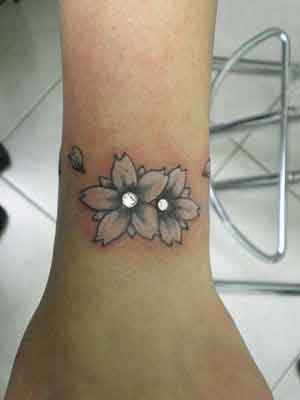
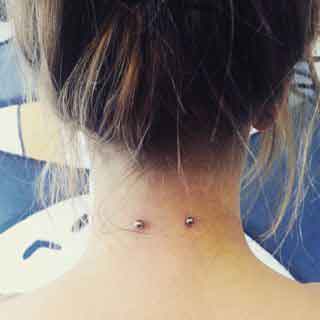
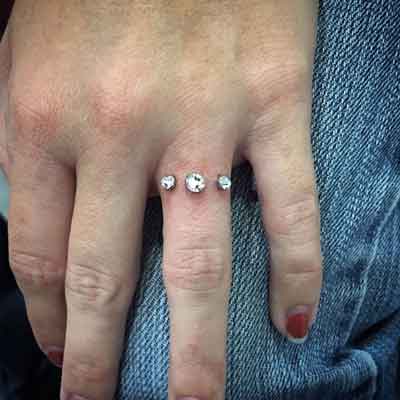
Dermal Piercing Jewelry and Accessories
There are different options in choosing a piercing. The material, function, and design are all customizable.
1) Dermal anchors
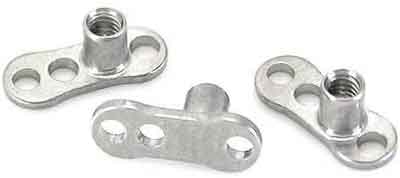
There are two types of dermal anchors.
First are round base anchors; these are smaller and less invasive.
However, it makes them less secure. The other one is footed anchors. They resemble a foot shape and are longer.
Furthermore, it extends beneath the skin, making it more secure and invasive. There are also other varieties on both anchors. A dermal anchor can often have holes in it to grab onto the tissue.
The holes ensure that the piercing doesn’t move as much and lower the risk of infection.
The other variety is a smooth dermal anchor with no holes, but these dermal piercings may not last.
2) Dermal tops
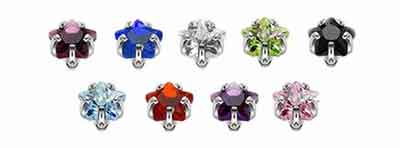
The dermal top or external jewelry top is found above the skin. It is screwed on the dermal anchor and can be changed for ornamental purposes.
A certified piercer will carefully maneuver its removal by screwing and unscrewing the microdermal stud.
There are also options for getting a magnetic dermal top. It makes changing and removing the dermal top easier without a trained professional.
3) Skin divers
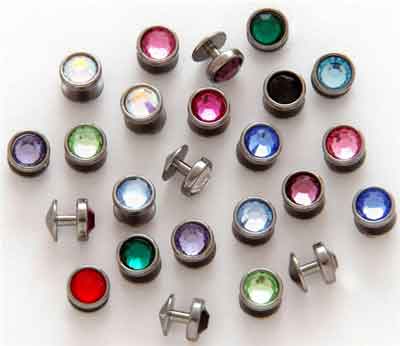
A skin diver is a type of piercing that cannot be interchanged. It has a pointed-end base and preset jewelry on top.
A piercer makes a biopsy punch to create a pouch for the end of the skin diver, which heals over. The materials used are essential details in choosing body jewelry for your piercings.
There are different things to consider, its cost and the chances of irritation.
This will also depend on your preferences and skin type.
4) Surgical titanium
Surgical titanium or anodized titanium is a metal coated with titanium. This is preferable for people with sensitive skin because titanium is less likely to cause irritation.
5) Surgical grade stainless steel
Always look for surgical-grade materials. This is one of the most popular types of metals used in piercings. It is a safe metal for dermal piercings.
However, it has a higher risk for irritation.
6) Niobium
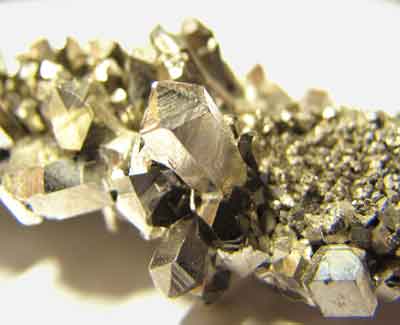
This metal is similar to titanium but more expensive. Niobium is hypoallergenic and non-corrosive.
It is better to get high-quality materials if possible, so you can avoid any harm to your skin.
7) Gold
A preferred type of gold for dermal piercings is 14-karat yellow or white gold. 18 karat gold and higher are less durable.
There is also a higher risk for allergic reaction or infection with gold-plated jewelry.
How to Get a Dermal Piercing
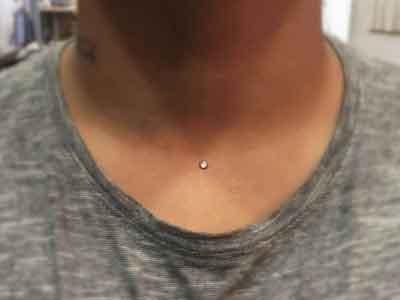
It is essential to choose a proper piercing studio or professional piercers when having a dermal piercing. Its procedure is more complicated and may cause issues if not correctly done.
The dermal layer of the skin where the piercing is anchored contains blood vessels and nerves.
A professional piercer will be able to embed the piercing without causing damage to these tissues safely.
There are two ways a piercing is embedded. A dermal punch or skin punch is a more invasive method. A piercer will remove a small tube of flesh to create a pouch.
Another method is by a needle; it creates an L-shaped pouch by separating the skin.
The needle used is specially made for dermal piercing only.
Additionally, its size will vary according to the location or the thickness of the skin.
If the two are compared, dermal punches are less painful, safer, and reduce the chances of rejection of the dermal piercing than with a needle.
The equipment used by a piercing studio should be sterilized and of high quality.
The risks of infection in dermal piercings are much higher if done in an unsanitary environment.
The first step in dermal piercing is finding a reputable piercing studio and piercer.
- A professional piercer will first examine the area of the skin to be pierced if it won’t have any issues and is fit to be pierced.
- The determined piercing site is then sterilized with a surgical scrub and marked with a pen.
- The piercer uses either a needle or a dermal punch to create a pouch.
- An anchor is inserted into the hole created on the skin using dermal forceps or a dermal holder tool.
- The anchor is pushed in entirely and positioned correctly.
- Finally, the dermal jewelry is screwed onto the head of the anchor.
Difference Between Surface and Dermal
 There are two types of skin piercing. Dermal piercing and surface piercing may offer similar aesthetics, but they have several distinctions.
There are two types of skin piercing. Dermal piercing and surface piercing may offer similar aesthetics, but they have several distinctions.
The considerations for getting them done are very different.
When people hear about piercings, they may often be reminded of surface piercings.
A surface piercing has a separate entry and exit point, unlike dermal piercing that has a single point surface piercing.
The jewelry used in this piercing is called barbells.
It is inserted into the flesh where both ends are sitting on the surface of the skin and the middle bar sits below the flesh as an anchor.
They pinch the area of the skin and puncture it with a needle, which creates a passage for the piercing.
Dermal piercing is a more complicated procedure than surface piercing. Surface piercings are often attempted at home.
The risk of infection and its aftercare is also less risky.
Dermal Piercing Aftercare
Dermal piercings may be harder to maintain, but as long as you follow these steps, you will keep your piercing in good shape.
Rejection is a common complaint in dermal piercing.
Some individuals may have a higher chance of their body rejecting a dermal piercing.
However, you can minimize this and keep your dermal piercing in place longer.
The best choices for dermal piercings are a location with more skin and using titanium or niobium.
An anchor with holes will also ensure the stability of your dermal piercing. The choices you make before getting a piercing are crucial in maintaining it.
Some materials and methods make it easier to keep your piercing healthy.
You can ask a trained professional about your personal preferences and what would best apply to you.
To avoid needing the removal of a piercing. You must take care of your dermal piercing during its healing process.
A new piercing is easy to snag and may hurt a lot. The healing time for a dermal piercing may last for 1 to 3 months. This will depend on the location of the piercing.
The healing time will also depend on the person and how the piercing is taken care of.
Some aftercare recommendations are:
- The piercing site will be covered for a few days. After this phase, you should gently wipe the location with saline solution (or a mixture of sea salt and water). Clean your piercing by dabbing or spraying the saline solution. Blot it dry with a paper towel. Each time you clean the piercing and dry it use a new paper towel.
- Do not touch your dermal piercing with dirty hands. Always wash your hands with antibacterial soap before cleaning your piercing.
- When you shower, do not wash the area with heavy soap that is drying. Excessive washing with soap may irritate it. Nevertheless, it is okay to get soapy water on it.
- Keep the area moisturized with gentle oils.
- Apply diluted tea tree oil on the area occasionally. Tea tree oil will help prevent infection but only use it sparingly.
- When you see crusting on the surrounding skin of your piercing, do not pick at it or remove it by force.
- Don’t wear tight clothing on the area of your new piercing. Tight clothing may tug at your piercing and cause pain. It may also cause a red bump to develop.
- Do not attempt to move the anchor top around while it’s healing. Too much movement of the piercing will cause the anchor to migrate before it heals onto the skin.
Dermal Piercing Removal
Do not attempt to remove your piercing on your own. Always consult a trained professional about the removal of a dermal piercing.
You may decide to have your piercing removed if there are issues with it, such as:
- If your skin starts to swell or feels hot to the touch around the piercing for a long time.
- If you suspect an infection or allergic reaction.
- If an old dermal piercing becomes tight or painful.
Removal methods are done by a professional.
The dermal piercing area is gently massaged to dislodge the piercing, or the anchor is twisted to break the skin.
If the piercing is old, it may be more challenging to remove.
If the tissues around the anchor have grown on it, a piercer will make a small incision relative to the size of the anchor base.
They will use a scalpel for the incision or maneuver it with a tweezer.
Dermal piercing removal may be considered as microsurgery.
If you attempt to remove it at home, it could result in scar tissue on the surface of the skin.
Moreover, after getting your dermal piercing removed, keep the area sanitized to avoid infection.
You can take some over-the-counter pain relievers to help ease the pain. If the wound won’t heal or you experience severe pain, go to a doctor right away.
What You Need to Know Before Getting One
A dermal piercing may have a few risks when undergoing the procedure and during the healing process.
The side effects will vary for every individual, and several factors will contribute to it.
While it is not as extreme as a body modification, it still implies a few risks.
Risks involved in dermal piercing:
1) Migration and rejection
Dermal piercings are prone to migration or rejection because they cannot penetrate deep into the skin.
Rejection can also happen when your body cells react to the piercing by pushing it out.
The skin tissues recognize the piercing as a foreign object and avoid it. You may experience jewelry displacement where the jewelry top droops on the skin’s surface.
Nevertheless, with proper care and choices, you will be able to avoid piercing rejection.
A dermal punch and a location with thick skin can lessen its risk.
2) Tissue damage
Tissue damage can occur when the procedure is incorrectly done. Thus, it is critical to choose a skilled professional.
The dermal layer where the piercing is placed contains several nerves that can be damaged.
If it is installed too deeply in the skin, the piercing may cause embedding of the skin layers.
Twisting and pulling off the dermal top can also cause irreversible damage.
3) Infection
During the dermal piercing procedure, non-sterilized equipment and lack of sanitation at the piercing studio can cause cellulitis or infection to your piercing.
Improper aftercare during the healing process can also accumulate bacteria on your piercing.
Antibacterial soap and saline solution are essential in preventing infections.
Symptoms of infection include inflammation, redness, green pus, and pain in the surrounding area.
4) Hypergranulation
Hypergranulation is a red bump that appears around the small hole in your skin where the piercing is placed.
This occurs when the jewelry is too tight or too much pressure is applied to the area.
You can avoid this by wearing loose clothing and letting the area air out.
If the dermal top is screwed too tightly, you can ask your piercer to loosen it.
5) Scarring
If you remove the jewelry on your own or if your body rejects the piercing, this will cause permanent scarring on the surface of the skin.
To reduce risk, keep the area clean and moisturized. You can use gentle oils such as jojoba oil.
Bottom Line
Dermal piercings are unique and are a form of expression of art. Many people become attracted to its aesthetics.
Its design and customization are almost infinite. However, with its beauty comes the complexity of the procedure and healing.
If you are dedicated to having a dermal piercing, it is critical to remember the tips and instructions mentioned.
However, consult your healthcare provider to provide medical advice about dermal piercings if you have any skin conditions or fear the procedure.
The information provided here is for educational purposes only.
Talk with your piercer about any issues with your piercings.
